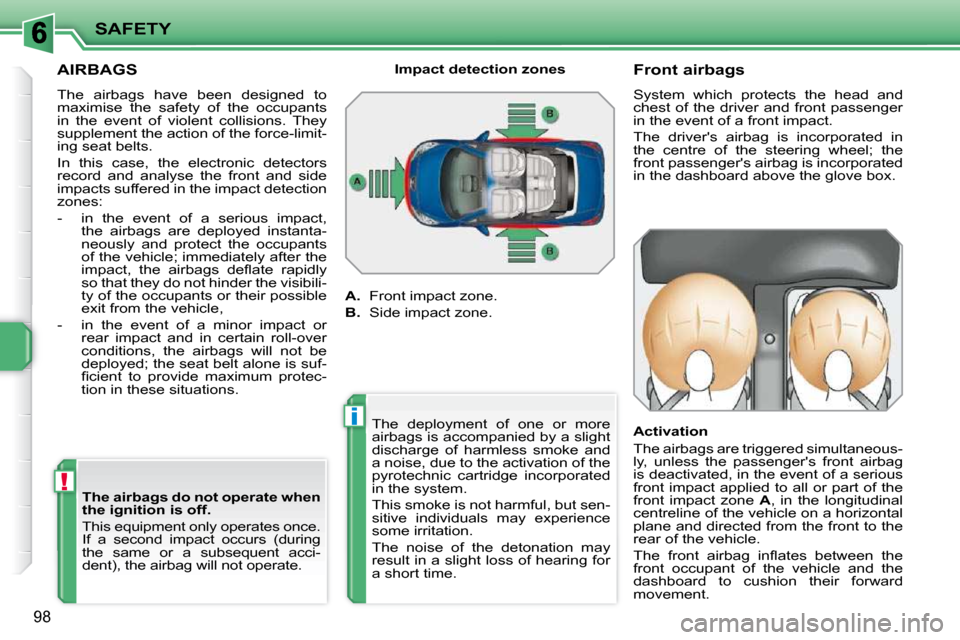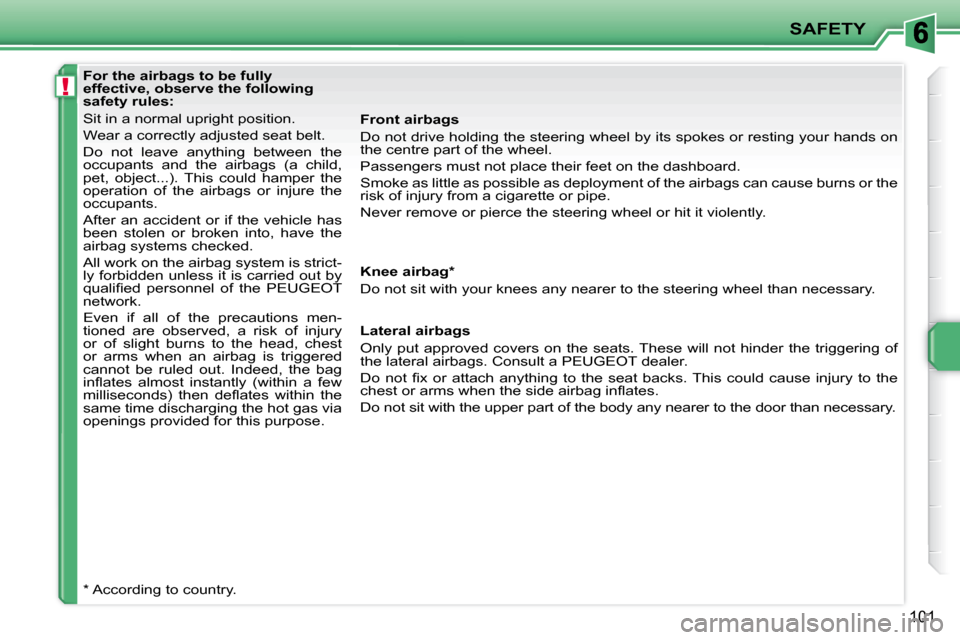2010 Peugeot 207 CC steering wheel
[x] Cancel search: steering wheelPage 108 of 207

!
i
SAFETY
98
AIRBAGS
The airbags have been designed to
maximise the safety of the occupants
in the event of violent collisions. They
supplement the action of the force-limit-
ing seat belts.
In this case, the electronic detectors
record and analyse the front and side
impacts suffered in the impact detection
zones:
- in the event of a serious impact, the airbags are deployed instanta-
neously and protect the occupants
of the vehicle; immediately after the
�i�m�p�a�c�t�,� �t�h�e� �a�i�r�b�a�g�s� �d�e�fl� �a�t�e� �r�a�p�i�d�l�y�
so that they do not hinder the visibili-
ty of the occupants or their possible
exit from the vehicle,
- in the event of a minor impact or rear impact and in certain roll-over
conditions, the airbags will not be
deployed; the seat belt alone is suf-
�fi� �c�i�e�n�t� �t�o� �p�r�o�v�i�d�e� �m�a�x�i�m�u�m� �p�r�o�t�e�c�-
tion in these situations.
The airbags do not operate when
the ignition is off.
This equipment only operates once.
If a second impact occurs (during
the same or a subsequent acci-
dent), the airbag will not operate. Impact detection zones
A. Front impact zone.
B. Side impact zone. Front airbags
System which protects the head and
chest of the driver and front passenger
in the event of a front impact.
The driver's airbag is incorporated in
the centre of the steering wheel; the
front passenger's airbag is incorporated
in the dashboard above the glove box.
Activation
The airbags are triggered simultaneous-
ly, unless the passenger's front airbag
is deactivated, in the event of a serious
front impact applied to all or part of the
front impact zone
A , in the longitudinal
centreline of the vehicle on a horizontal
plane and directed from the front to the
rear of the vehicle.
� �T�h�e� �f�r�o�n�t� �a�i�r�b�a�g� �i�n�fl� �a�t�e�s� �b�e�t�w�e�e�n� �t�h�e�
front occupant of the vehicle and the
dashboard to cushion their forward
movement.
The deployment of one or more
airbags is accompanied by a slight
discharge of harmless smoke and
a noise, due to the activation of the
pyrotechnic cartridge incorporated
in the system.
This smoke is not harmful, but sen-
sitive individuals may experience
some irritation.
The noise of the detonation may
result in a slight loss of hearing for
a short time.
Page 111 of 207

!
SAFETY
101
For the airbags to be fully
effective, observe the following
safety rules:
Sit in a normal upright position.
Wear a correctly adjusted seat belt.
Do not leave anything between the
occupants and the airbags (a child,
pet, object...). This could hamper the
operation of the airbags or injure the
occupants.
After an accident or if the vehicle has
been stolen or broken into, have the
airbag systems checked.
All work on the airbag system is strict-
ly forbidden unless it is carried out by
�q�u�a�l�i�fi� �e�d� �p�e�r�s�o�n�n�e�l� �o�f� �t�h�e� �P�E�U�G�E�O�T�
network.
Even if all of the precautions men-
tioned are observed, a risk of injury
or of slight burns to the head, chest
or arms when an airbag is triggered
cannot be ruled out. Indeed, the bag
�i�n�fl� �a�t�e�s� �a�l�m�o�s�t� �i�n�s�t�a�n�t�l�y� �(�w�i�t�h�i�n� �a� �f�e�w�
�m�i�l�l�i�s�e�c�o�n�d�s�)� �t�h�e�n� �d�e�fl� �a�t�e�s� �w�i�t�h�i�n� �t�h�e�
same time discharging the hot gas via
openings provided for this purpose.
* According to country. Front airbags
Do not drive holding the steering wheel by its spokes or resti
ng your hands on
the centre part of the wheel.
Passengers must not place their feet on the dashboard.
Smoke as little as possible as deployment of the airbags can cau se burns or the
risk of injury from a cigarette or pipe.
Never remove or pierce the steering wheel or hit it violently.
Knee airbag *
Do not sit with your knees any nearer to the steering wheel than necessary.
Lateral airbags
Only put approved covers on the seats. These will not hinder the triggering of
the lateral airbags. Consult a PEUGEOT dealer.
� �D�o� �n�o�t� �fi� �x� �o�r� �a�t�t�a�c�h� �a�n�y�t�h�i�n�g� �t�o� �t�h�e� �s�e�a�t� �b�a�c�k�s�.� �T�h�i�s� �c�o�u�l�d� �c�a�u�s�e� �i�n�j�u�r�y� �t�o� �t�h�e�
�c�h�e�s�t� �o�r� �a�r�m�s� �w�h�e�n� �t�h�e� �s�i�d�e� �a�i�r�b�a�g� �i�n�fl� �a�t�e�s�.�
Do not sit with the upper part of the body any nea rer to the door than necessary.
Page 130 of 207

i
PRACTICAL INFORMATION
120
TEMPORARY PUNCTURE
REPAIR KIT
Complete system consisting of a com-
pressor and an incorporated sealant
cartridge which permits temporary re-
pair of the tyre so that you can drive to
the nearest garage.
Access to the kit
This repair kit is available from
PEUGEOT dealers.
It is designed to repair most punc-
tures which could affect the tyre,
located on the tyre tread or shoul-
der. Avoid removing any foreign
bodies which have penetrated the
tyre. Using the kit
This procedure, comprising several
steps, must be carried out in full.
� Switch off the ignition.
�
Turn the selector A to the "SEALANT"
position.
� Check that the switch B is in position "0" .
� Connect the white pipe C to the
valve of the tyre to be repaired.
� Connect the compressor's electric
plug to the vehicle's 12 V socket.
� � � �A�f�fi� �x� �t�h�e� �s�p�e�e�d� �l�i�m�i�t�a�t�i�o�n� �s�t�i�c�k�e�r�
to the vehicle's steering wheel to
remind you that a wheel is in tem-
porary use.
� Start the vehicle and leave the en-
gine running.
Page 149 of 207

!i
PRACTICAL INFORMATION
139
TOWING THE VEHICLE
Procedure for having your vehicle towed
or for towing another vehicle using a re-
movable towing eye.
Access to the tools Towing your vehicle
� On the front bumper, pull on the cov-
er to unclip it.
� Screw the towing eye in fully.
� Install the towing bar.
� Switch on the hazard warning lamps
on the towed vehicle.
� On the rear bumper, unclip the cover
by pressing at the bottom.
� Screw the towing eye in fully.
� Install the towing bar.
� Switch on the hazard warning lamps
on the towed vehicle.
Towing another vehicle
The towing eye is installed in a holder at
�t�h�e� �b�o�t�t�o�m� �o�f� �t�h�e� �b�o�o�t� �u�n�d�e�r� �t�h�e� �fl� �o�o�r�.�
� �F�o�r� �a�c�c�e�s�s� �t�o� �i�t�:�
� � � �p�l�a�c�e� �t�h�e� �v�e�h�i�c�l�e� �i�n� �"�c�o�u�p�é�"� �c�o�n�fi� �g�u�-
ration,
� open the boot,
� � � �r�a�i�s�e� �t�h�e� �fl� �o�o�r�,�
� remove the towing eye from the
holder. When towing with all four wheels
on the ground, always use a towing
bar.
When towing with only two wheels
on the ground, always use profes-
sional lifting equipment.
When towing with the engine off,
there is no longer any braking or
steering assistance.
� Place the gear lever in neutral
(position N on the automatic
�g�e�a�r�b�o�x�)�.� �
� �F�a�i�l�u�r�e� �t�o� �o�b�s�e�r�v�e� �t�h�i�s� �s�p�e�c�i�fi� �c� instruction may result in damage
to certain braking units and the
absence of braking assistance
when the engine is restarted.
Page 199 of 207

190
�0�6
�1�1
�2�2
�1�1
�1�1
�2�2
�3�3
�2�2
�Y�E�S
� � �R�E�C�E�I�V�I�N�G� �A� �C�A�L�L�
� � �A�n� �i�n�c�o�m�i�n�g� �c�a�l�l� �i�s� �a�n�n�o�u�n�c�e�d� �b�y� �a� �r�i�n�g� �a�n�d� �a� �s�u�p�e�r�i�m�p�o�s�e�d� �d�i�s�p�l�a�y� �o�n� �t�h�e� �m�u�l�t�i�f�u�n�c�t�i�o�n� �s�c�r�e�e�n�.� � Initiate the pairing between the telephone and �t�h�e� �v�e�h�i�c�l�e�.� �T�h�i�s� �p�a�i�r�i�n�g� �c�a�n� �b�e� �i�n�i�t�i�a�t�e�d� �f�r�o�m� �t�h�e� �v�e�h�i�c�l�e�'�s� �t�e�l�e�p�h�o�n�e� �f�u�n�c�t�i�o�n� �m�e�n�u� �o�r� �v�i�a� �t�h�e� telephone's keypad. See steps 1 to 10 on the previous pages. During the pairing phase, the vehicle �m�u�s�t� �b�e� �s�t�a�t�i�o�n�a�r�y� �w�i�t�h� �t�h�e� �k�e�y� �i�n� �t�h�e� �i�g�n�i�t�i�o�n�.�
� �S�e�l�e�c�t� �t�h�e� �t�e�l�e�p�h�o�n�e� �t�o� �b�e� �c�o�n�n�e�c�t�e�d� �f�r�o�m� �t�h�e� �t�e�l�e �p�h�o�n�e� �f�u�n�c�t�i�o�n� �m�e�n�u�.� � �T�h�e� �a�u�d�i�o� �s�y�s�t�e�m� �c�o�n�n�e�c�t�s� �t�o� �a� �n�e�w�l�y� �p�a�i�r�e�d� �t�e�l�e�p�h �o�n�e� �a�u�t�o�m�a�t�i�c�a�l�l�y�.�
Select the YES tab on the display �u�s�i�n�g� �t�h�e� �b�u�t�t�o�n�s� �a�n�d� �c�o�n�fi� �r�m� �b�y� �p�r�e�s�s�i�n�g� �O�K�.� �
� � �P�r�e�s�s� �t�h�e� �s�t�e�e�r�i�n�g� �m�o�u�n�t�e�d� �c�o�n�t�r�o�l� �O�K� �t�o� �a�c�c�e�p�t� the call.
� � �F�r�o�m� �t�h�e� �B�l�u�e�t�o�o�t�h� �t�e�l�e�p�h�o�n�e� �f�u�n�c�t�i�o�n� �A�u�d�i�o� �m�e�n�u�,� �s�e�l�e�c�t� �M�a�n�a�g�e� the telephone call then Call, Call list or Directory.
� � �P�r�e�s�s� �t�h�e� �e�n�d� �o�f� �t�h�e� �s�t�e�e�r�i�n�g� �m�o�u�n�t�e�d� �c�o�n�t�r�o�l� �f�o�r� �m�o�r�e� �t�h�a�n� �t�w�o� �s�e�c�o�n�d�s� �t�o� �g�a�i�n� �a�c�c�e�s�s� �t�o� �y�o�u�r� directory. Or � �T�o� �d�i�a�l� �a� �n�u�m�b�e�r�,� �u�s�e� �y�o�u�r� �t�e�l�e�p�h�o�n�e�'�s� �k�e�y�p�a�d�,� �w�i�t �h� the vehicle stationary.
� � �M�A�K�I�N�G� �A� �C�A�L�L�
�B�L�U�E�T�O�O�T�H� �A�U�D�I�O� �S�T�R�E�A�M�I�N�G� �
�(�A�V�A�I�L�A�B�L�E� �D�U�R�I�N�G� �T�H�E� �Y�E�A�R�)�
� �W�i�r�e�l�e�s�s� �t�r�a�n�s�m�i�s�s�i�o�n� �o�f� �t�h�e� �t�e�l�e�p�h�o�n�e�'�s� �m�u�s�i�c� �fi� �l�e�s� �v�i�a� �t�h�e� �a�u�d�i�o� �e�q�u�i�p�m�e�n�t�.� �T�h�e� �t�e�l�e�p�h�o�n�e� �m�u�s�t� �b�e� �a�b�l�e� �t�o� �m�a�n�a�g�e� �t�h�e � �a�p�p�r�o�p�r�i�a�t�e� �b�l�u�e�t�o�o�t�h� �p�r�o�fi� �l�e�s� �(�P�r�o�fi� �l�e�s� �A�2�D�P�/�A�V�R�C�P�)�.�
� � �*� � � �I�n� �c�e�r�t�a�i�n� �c�a�s�e�s�,� �p�l�a�y�i�n�g� �o�f� �t�h�e� �A�u�d�i�o� �fi� �l�e�s� �m�u�s�t� �b�e� �i�n�i�t�i�a�t�e�d� �f�r�o�m� �t�h�e� keypad. ** If the telephone supports the function.
� �A�c�t�i�v�a�t�e� �t�h�e� �s�t�r�e�a�m�i�n�g� �s�o�u�r�c�e� �b�y� �p�r�e�s�s�i�n�g� �t�h�e� �S�O�U�R�C�E� �b�u�t�t�o�n� �*� �.� �T�h�e� tracks to be played can be controlled �a�s� �u�s�u�a�l� �v�i�a� �t�h�e� �b�u�t�t�o�n�s� �o�n� �t�h�e� �R�a�d�i�o� control panel and the steering wheel �c�o�n�t�r�o�l�s� �*�*� �.� �T�h�e� �c�o�n�t�e�x�t�u�a�l� �i�n�f�o�r�m�a�t�i�o�n� can be displayed on the screen.
� �B�L�U�E�T�O�O�T�H�